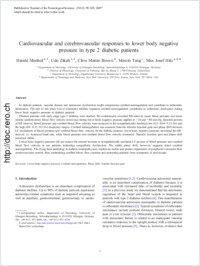Cardiovascular and cerebrovascular responses to lower body negative pressure in type 2 diabetic patients
- Marthol, Harald Department of Neurology, University of Erlangen-Nuremberg, Germany
- Zikeli, Udo Department of Neurology, University of Erlangen-Nuremberg, Germany
- Brown, Clive M. Division of Physiology, University of Fribourg, Switzerland
- Tutaj, Marcin Department of Neurology, Jagiellonian University, Krakow, Poland
- Hilz, Max Josef Department of Neurology, University of Erlangen-Nuremberg, Germany - Departments of Neurology and Medicine, New York University, USA
-
31.01.2007
Published in:
- Journal of the Neurological Sciences. - 2007, vol. 252, no. 2, p. 99-105
English
In diabetic patients, vascular disease and autonomic dysfunction might compromise cerebral autoregulation and contribute to orthostatic intolerance. The aim of our study was to determine whether impaired cerebral autoregulation contributes to orthostatic intolerance during lower body negative pressure in diabetic patients. Thirteen patients with early-stage type 2 diabetes were studied. We continuously recorded RR-interval, mean blood pressure and mean middle cerebral artery blood flow velocity at rest and during lower body negative pressure applied at − 20 and − 40 mm Hg. Spectral powers of RR-interval, blood pressure and cerebral blood flow velocity were analyzed in the sympathetically mediated low (LF: 0.04–0.15 Hz) and the high (HF: 0.15–0.5 Hz) frequency ranges. Cerebral autoregulation was assessed from the transfer function gain and phase shift between LF oscillations of blood pressure and cerebral blood flow velocity. In the diabetic patients, lower body negative pressure decreased the RR-interval, i.e. increased heart rate, while blood pressure and cerebral blood flow velocity decreased. Transfer function gain and phase shift remained stable. Lower body negative pressure did not induce the normal increase in sympathetically mediated LF-powers of blood pressure and cerebral blood flow velocity in our patients indicating sympathetic dysfunction. The stable phase shift, however, suggests intact cerebral autoregulation. The dying back pathology in diabetic neuropathy may explain an earlier and greater impairment of peripheral vasomotor than cerebrovascular control, thus maintaining cerebral blood flow constant and protecting patients from symptoms of presyncope.
- Faculty
- Faculté des sciences et de médecine
- Department
- Département de Médecine
- Language
-
- English
- Classification
- Biological sciences
- License
-
License undefined
- Identifiers
-
- RERO DOC 8674
- DOI 10.1016/j.jns.2006.10.003
- Persistent URL
- https://folia.unifr.ch/unifr/documents/300580
Statistics
Document views: 173
File downloads:
- pdf: 201
